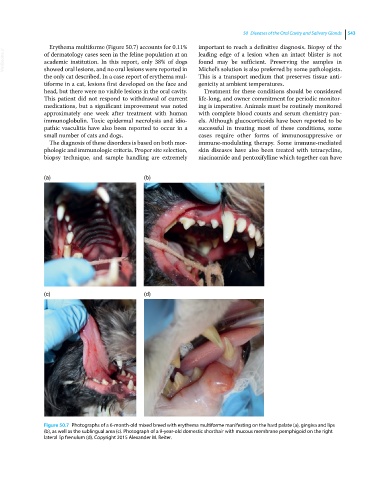Page 575 - Clinical Small Animal Internal Medicine
P. 575
50 Diseases of the Oral Cavity and Salivary Glands 543
Erythema multiforme (Figure 50.7) accounts for 0.11% important to reach a definitive diagnosis. Biopsy of the
VetBooks.ir of dermatology cases seen in the feline population at an leading edge of a lesion when an intact blister is not
found may be sufficient. Preserving the samples in
academic institution. In this report, only 38% of dogs
showed oral lesions, and no oral lesions were reported in
This is a transport medium that preserves tissue anti
the only cat described. In a case report of erythema mul Michel’s solution is also preferred by some pathologists.
tiforme in a cat, lesions first developed on the face and genicity at ambient temperatures.
head, but there were no visible lesions in the oral cavity. Treatment for these conditions should be considered
This patient did not respond to withdrawal of current life‐long, and owner commitment for periodic monitor
medications, but a significant improvement was noted ing is imperative. Animals must be routinely monitored
approximately one week after treatment with human with complete blood counts and serum chemistry pan
immunoglobulin. Toxic epidermal necrolysis and idio els. Although glucocorticoids have been reported to be
pathic vasculitis have also been reported to occur in a successful in treating most of these conditions, some
small number of cats and dogs. cases require other forms of immunosuppressive or
The diagnosis of these disorders is based on both mor immune‐modulating therapy. Some immune‐mediated
phologic and immunologic criteria. Proper site selection, skin diseases have also been treated with tetracycline,
biopsy technique, and sample handling are extremely niacinamide and pentoxifylline which together can have
(a) (b)
(c) (d)
Figure 50.7 Photographs of a 6‐month‐old mixed breed with erythema multiforme manifesting on the hard palate (a), gingiva and lips
(b), as well as the sublingual area (c). Photograph of a 9‐year‐old domestic shorthair with mucous membrane pemphigoid on the right
lateral lip frenulum (d). Copyright 2015 Alexander M. Reiter.

